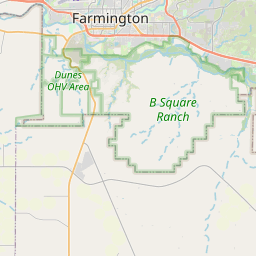City of Bloomfield
Historical marker location:
US 64, Bloomfield, New Mexico
( west side of Bloomfield)






© OpenStreetMap contributors
Prehistoric farmers established major communities along the rivers of this region in the eleventh century. Eight hundred years later, historic settlement was also made possible by abundant water. Bloomfield was established in 1879 near a site which afforded a safe crossing of the San Juan River. The hard lives of the early settlers gradually gave way to increasing prosperity made possible by irrigation farming and horticulture
In the early 1800s, New Mexico became an important center for trade along the Santa Fe Trail, which connected Missouri to Santa Fe. The trail was used by traders, trappers, and settlers to transport goods and supplies across the frontier.
About San Juan County
San Juan County Timeline
San Juan County, located in the northwestern corner of New Mexico, has a rich and complex history that spans thousands of years. The area has long been inhabited by indigenous peoples, including the Navajo, Ute, and Pueblo tribes. These tribes developed vibrant cultures, which left traces in the form of petroglyphs, artifacts, and ancient dwellings found throughout the region.
In the 16th century, Spanish explorers arrived in the area, seeking wealth and spreading Catholicism. The Spanish established Santa María de Galisteo, one of the earliest European settlements in present-day San Juan County. However, it was not until the 1870s that significant Anglo-American settlement occurred, driven by the discovery of valuable resources.
The most significant turning point in the region's history came with the discovery of oil and natural gas in the early 20th century. The discovery of the San Juan Basin, one of the largest natural gas fields in the United States, led to a population boom and economic growth. Farming and ranching also played a vital role in the early development of San Juan County. The towns of Farmington and Aztec emerged as important centers of commerce and industry during this time.
Over the years, the economy of San Juan County has experienced highs and lows. The area has been impacted by declining oil prices, environmental concerns, and shifts in energy production. However, the county continues to be a significant producer of natural resources, including coal, oil, gas, and uranium. Today, the county is also renowned for its stunning landscapes, outdoor recreational opportunities, and unique cultural heritage, attracting visitors from around the world.
In the 16th century, Spanish explorers arrived in the area, seeking wealth and spreading Catholicism. The Spanish established Santa María de Galisteo, one of the earliest European settlements in present-day San Juan County. However, it was not until the 1870s that significant Anglo-American settlement occurred, driven by the discovery of valuable resources.
The most significant turning point in the region's history came with the discovery of oil and natural gas in the early 20th century. The discovery of the San Juan Basin, one of the largest natural gas fields in the United States, led to a population boom and economic growth. Farming and ranching also played a vital role in the early development of San Juan County. The towns of Farmington and Aztec emerged as important centers of commerce and industry during this time.
Over the years, the economy of San Juan County has experienced highs and lows. The area has been impacted by declining oil prices, environmental concerns, and shifts in energy production. However, the county continues to be a significant producer of natural resources, including coal, oil, gas, and uranium. Today, the county is also renowned for its stunning landscapes, outdoor recreational opportunities, and unique cultural heritage, attracting visitors from around the world.
San Juan County Timeline
This timeline provides a concise overview of the key events in the history of San Juan County, New Mexico.
- 1200 - Ancient Puebloan people settle in the area, building cliff dwellings and cultivating corn, beans, and squash.
- 1539 - Spanish explorer Francisco Vásquez de Coronado explores the region searching for the Seven Cities of Gold.
- 1776 - Spanish settlers establish the first permanent settlement, named San Juan Pueblo, in the area.
- 1848 - The Treaty of Guadalupe Hidalgo is signed, leading to the transfer of the region from Mexico to the United States.
- 1870 - The U.S. government establishes Fort Wingate in the area to protect settlers from Native American attacks.
- 1876 - Aztec, the county seat of San Juan County, is founded as a trading post and agricultural community.
- 1948 - Oil and gas exploration begins, leading to significant economic growth and the influx of new residents.
- 1959 - Navajo Dam is completed on the San Juan River, creating Navajo Lake and providing water and hydroelectric power.
- 1984 - The Four Corners Power Plant begins operation, becoming the largest coal-fired power plant in the western United States.
- 2015 - The Gold King Mine spill occurs, releasing millions of gallons of toxic wastewater into the Animas River.